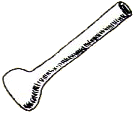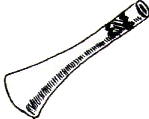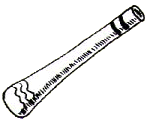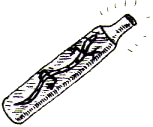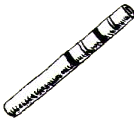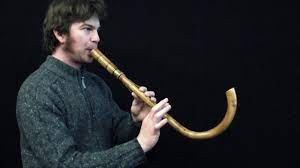roughbarked said:
roughbarked said:
SCIENCE said:
so termites invented didgeridoo
No no no no, yes but no.
Where Does the Word Didgeridoo Come From?
The fact that bamboo didjeridus were quite common among northerly groups in the Northern Territory during the last century is confirmed by the word ‘bamboo’ which is still used in the lingua franca by some Aborigines when referring to the instrument, though ‘didjeridu’ may be gaining ground.
The suggestion here is that the first didjeridus were of bamboo; and that because of the availability of bamboo in the north-western region of the Northern Territory, the first didjeridu players may well have belonged to that region. Some observations on ‘three very curious trumpets’ made by R.Etheridge Jr. in 1893 are quoted for consideration in this context as they refer particularly to instruments of bamboo. Etheridge writes that ‘ are made from bamboo lengths, the diaphragms having been removed, probably by dropping live coals down the tubes.
The bamboo, I am informed by Mr Stockdale, grows about the Adelaide River over an area of about one hundred miles by fifty, and reaches to a height of eighty feet, Mr J.H. Maiden tells me there are two bamboos indigenous in Australia, Bambusa arnhemica and B.moreheadiana, the latter a climbing species and only one or two inches in diameter.

I went looking through Trove newspapers for any mention of the didgeridoo, under any name.
At first, I found no reference before 1908, then none until 1918.
Then just as I was about to give up, I found a reference from 1858 which is startlingly unusual.
I can eliminate two possibilities up front.
- The word did not come from Bendidgerie, as in Bendidgerie station on Bendidgerie Ck.
- The word did not come from Murrumdidgerie, an alternative pronunciation of Murrumbidgee.
I cannot rule out the possibility yet that the word Didgerie came from the English name Diggory. There was a Diggory/Didgery around in 1877, if not before, and the reference from 1858 doesn’t mention the word “didgeridoo”. Temporarily ignoring the 1858 reference, let’s see what the newspapers tell us.
- Hollow sticks in general and hollow bamboos in particular, had been used by Europeans for smuggling purposes for over 100 years. For example, “it was not until 552 AD that the Byzantine emperor Justinian obtained the first silkworm eggs. He had sent two Nestorian monks to Central Asia, and they were able to smuggle silkworm eggs to him hidden in rods of bamboo.”
- In Australia, hollow sticks were used to smuggle tin as early as 1833. Documents and poiniards were also hidden by whites in hollow sticks.
- By 1898-1899 in Australia, chinese firecrackers had been made out of hollow sticks. And also a gun.
- In 1900, an aboriginal was using a hollow stick to imitate a telescope.
Turning north from Australia.
- By 1972, a hollow stick was used to collect and carry poison on Mivo Island (Bougainville).
- By 1884, in New Guinea, long hollow bamboo sticks were used as pipes for smoking betel-nut and opium.
- By 1890, in Borneo, hollow sticks were used as drinking straws.
- By 1890, in the New Hebredes and Fiji, hollow sticks were used as musical instruments, but not for blowing like a pipe or horn, instead beated together.
Back to Australia. The first appearance of the word “did-gery-do” in the newspapers is in 1908. Used to blow into by the Mootburra tribe of the Northern Territory near Black Gin Creek. A recent reference puts this tribal location possibly NE of Newcastle Waters homestead. Story by S.E. Pearson.
The second appearance of the word “didgeridoo” in the newspapers is in 1919. “The didgeriedoo is a hollow stick which the abos use to make a sort of music”, from a story with an imprecise location “far out on the fringe of the never never”.
The third appearance of the word “didgeri-doo” in the newspapers is in 1923, and this is the first one to associate it with any specific aboriginal activity. The location is given imprecisely as “The Territory”. Part of the quote is “to make rain … the doleful humming of the didgeri-doo and the tom-tom”
By 1952, “Didgerido” was the name of a racehorse.
So there the situation seemed to rest, it seemed possible that aboriginal people had copied the didgeridoo from the hollow bamboos of the whites, or obtained it as a cast-off pipe from the New Guinea natives. But the 1853 reference eliminates both possibilities.
02 July 1853. Newspaper “Empire”.
“THE ABORIGINES OF AUSTRALIA.—No. 5. LANGUAGE—MUSIC—MORE OF WARFARE.—HUNTING—HUNTING-GROUNDS—MODE OF PUNISH MENT.”
The soothing powers of the musical art are not altogether unknown among the
aborigines. In their corroborees they sing and beat time with sticks, and their dance
is performed to a rude species of music, “vocal and instrumental.” Their musical
instruments are few, two sorts being all that have been discovered. One of these
is described as a species of kettle drum, formed of kangaroo skin and a piece of
hollow timber, the former drawn tightly over the latter, and secured at the sides,
something after the fashion of the instrument in use among Europeans. The other
is described as a species of pipe, made of bamboo, about three feet in length. The
manner of sounding this instrument is a novelty in the musical world, as it is the
only instrument known which is operated on by the nasal organ. Such is the me-
thod of sounding it as practised by the sable musicians, who succeed in producing
thereby a droning noise, not unlike the tones of the bagpipe.
A nose flute!


